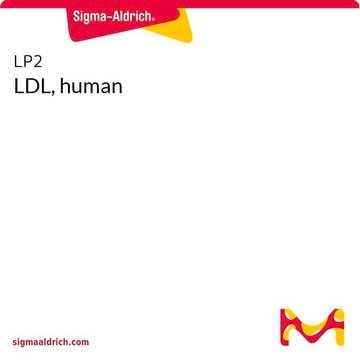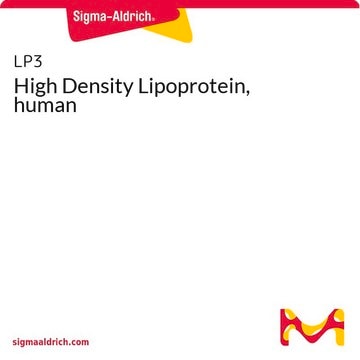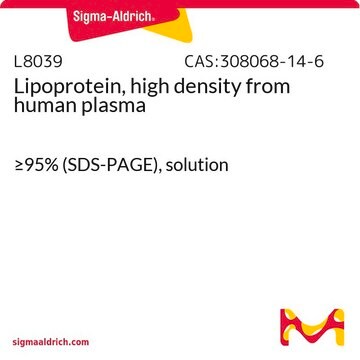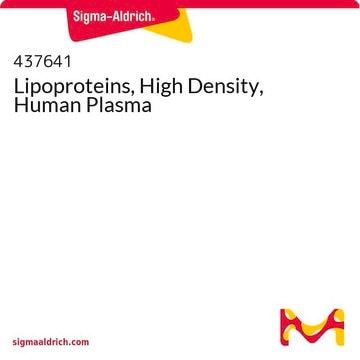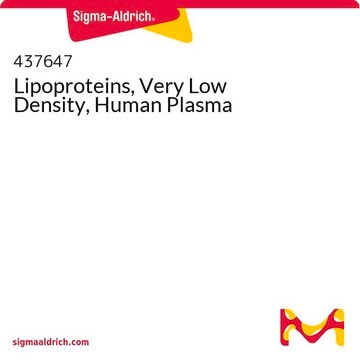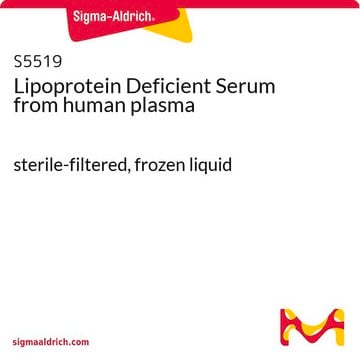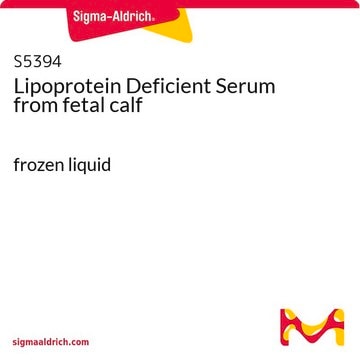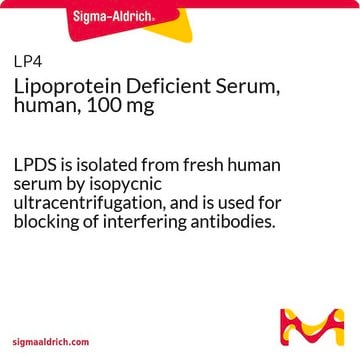437644
Lipoproteine niedriger Dichte in Humanplasma
Synonym(e):
LDL
Anmeldenzur Ansicht organisationsspezifischer und vertraglich vereinbarter Preise
Alle Fotos(1)
About This Item
UNSPSC-Code:
12352202
NACRES:
NA.25
Empfohlene Produkte
Assay
≥95% (of total lipoprotein content, electrophoresis)
Qualitätsniveau
Form
liquid
Hersteller/Markenname
Calbiochem®
Lagerbedingungen
do not freeze
protect from light
Versandbedingung
wet ice
Lagertemp.
2-8°C
Allgemeine Beschreibung
In einem 10-mg-Fläschchen sind ungefähr 2 mg Protein enthalten.
Natives Lipoprotein mit niedriger Dichte aus menschlichem Plasma. Der Cholesterin-Träger Lipoprotein ist für den Transport der Lipide (Cholesterin) von der Leber zu den Geweben verantwortlich. Zusammensetzung: 78–81 % Lipide und 19–22 % Proteine.
Natives Lipoprotein niedriger Dichte aus menschlichem Plasma. Der Cholesterin-Träger Lipoprotein ist für den Transport der Lipide (Cholesterin) von der Leber zu den Geweben verantwortlich. (Zusammensetzung: 78–81 % Lipide und 19–22 % Proteine. Hinweis: In einem 10-mg-Fläschchen sind ungefähr 2 mg Protein enthalten.)
Verpackung
Die chargenspezifische Konzentration entnehmen Sie bitte dem Fläschchenetikett.
Warnhinweis
Toxizität: Standard-Handhabung (A)
Physikalische Form
In 150 mM NaCl, 0,01 % EDTA, pH 7,4.
Angaben zur Herstellung
Aus Plasma hergestellt, das in zertifizierten Tests für HBsAg und Antikörper gegen HIV und HCV als negativ befunden wurde.
Rekonstituierung
Dieses Produkt enthält keine Konservierungsstoffe und sollte demnach unter einer Laminar-Flow-Haube verwendet werden. Nach erstmaligem Gebrauch ist dieses Produkt für 1 Woche lang bei 2–8 °C stabil.
Sonstige Hinweise
Foster, J.D., et al. 1993. Endocrinology132, 337.
Retsky, K.L., et al. 1993. J. Biol. Chem. 268, 1304.
Fielding, C.J. 1992. FASEB J. 6, 3162.
Retsky, K.L., et al. 1993. J. Biol. Chem. 268, 1304.
Fielding, C.J. 1992. FASEB J. 6, 3162.
Rechtliche Hinweise
CALBIOCHEM is a registered trademark of Merck KGaA, Darmstadt, Germany
Lagerklassenschlüssel
12 - Non Combustible Liquids
WGK
nwg
Flammpunkt (°F)
Not applicable
Flammpunkt (°C)
Not applicable
Analysenzertifikate (COA)
Suchen Sie nach Analysenzertifikate (COA), indem Sie die Lot-/Chargennummer des Produkts eingeben. Lot- und Chargennummern sind auf dem Produktetikett hinter den Wörtern ‘Lot’ oder ‘Batch’ (Lot oder Charge) zu finden.
Besitzen Sie dieses Produkt bereits?
In der Dokumentenbibliothek finden Sie die Dokumentation zu den Produkten, die Sie kürzlich erworben haben.
Kunden haben sich ebenfalls angesehen
Jiawei Chen et al.
The Biochemical journal, 393(Pt 1), 255-265 (2005-09-22)
LOX-1, a receptor for ox-LDL (oxidized low-density lipoprotein), has recently been determined to play a critical role in the progression of atherosclerosis. LOX-1 expression (mRNA and protein) has been shown to be up-regulated by pro-atherogenic stimuli, such as ox-LDL and
Eui-Jung Park et al.
FASEB journal : official publication of the Federation of American Societies for Experimental Biology, 34(2), 3379-3398 (2020-01-11)
Aquaporin-5 (AQP5) plays a role in breast cancer cell migration. This study aimed to identify AQP5-targeting miRNAs and examine their effects on breast cancer cell migration through exosome-mediated delivery. Bioinformatic analyses identified miR-1226-3p, miR-19a-3p, and miR-19b-3p as putative regulators of
Se-Hyun Oh et al.
FASEB journal : official publication of the Federation of American Societies for Experimental Biology, 33(6), 7301-7314 (2019-03-13)
Hypercholesterolemia is reported to increase reactive oxygen species (ROS) and to promote breast cancer progression. ROS play an important role in tumor biology, and xanthine oxidase (XO) is an enzyme that generates ROS. The effects of febuxostat (FBX), an XO
Brett M Stevens et al.
STAR protocols, 2(1), 100248-100248 (2021-01-14)
Isolation of leukemia stem cells presents a challenge due to the heterogeneity of the immunophenotypic markers commonly used to identify blood stem cells. Several studies have reported that relative levels of reactive oxygen species (ROS) can be used to enrich
Yaw Asare et al.
Frontiers in physiology, 11, 673-673 (2020-07-07)
Atherogenesis and arterial remodeling following mechanical injury are driven by inflammation and mononuclear cell infiltration. The binding of immune complexes (ICs) to immunoglobulin (Ig)-Fc gamma receptors (FcγRs) on most innate and adaptive immune cells induces a variety of inflammatory responses
Unser Team von Wissenschaftlern verfügt über Erfahrung in allen Forschungsbereichen einschließlich Life Science, Materialwissenschaften, chemischer Synthese, Chromatographie, Analytik und vielen mehr..
Setzen Sie sich mit dem technischen Dienst in Verbindung.

